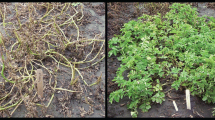Abstract
It was nearly 100 years ago that the decline in quality and yield observed in potato crops was attributed to the accumulation of pathogens in seed tubers saved from one field generation to the next. As a direct result of this realization, seed potato certification programs have been initiated throughout the world. While these programs have different administrative structures and employ various methodologies, they are all dedicated to the primary goal of producing a sufficient volume of high quality seed tubers as free from disease causing organisms as possible. Viral diseases are especially problematic because they have serious economic affects and their physical and biological properties make them difficult to control. Until recently, certification programs have relied on methodologies including the use of virus-free material obtained from tissue culture, strict adherence to practices that minimize the mechanical and insect spread of virus, physical inspection of seed increase plots to identify and minimize the number of virus-infected plants, and the increase of seed materials for only a limited number of years to insure that any infected materials are “flushed out” of the system. Approximately 10 years ago, it was first observed that virus resistance can be obtained by using transformation techniques to insert viral genes into the genome of plants. Subsequently, researchers in private and public laboratories have shown that potato plants produced in this way are highly resistant or immune to several viral diseases. The effect that the deployment of these materials may have on the seed potato certification process is the subject of this paper.
Similar content being viewed by others
Literature Cited
Beachy, R.N., S. Loesch-Fries, and N.E. Tummer. 1990. Coat protein-mediated resistance against virus infection. Annual Review of Phytopathology 28:451–474.
DeBoer, S.H., S.A. Slack, G.W. van den Bovenkamp, and I. Mastenbrock. 1996. A role for pathogen indexing procedures in potato certification. Advances in Botanical Research 23:217–242.
Pappu, H.R., C.L. Niblett, and R.F. Lee. 1995. Application of recombinant DNA technology to plant protection: molecular approaches to engineering virus resistance in crop plants. World Journal of Microbiology and Biotechnology 11:426–437.
Powell-Abel, P., R.S. Nelson, B. De, N. Hoffman, S.G. Rogers, R.T. Fraley, and R.N. Beachy. 1986. Delay of disease development in transgenic plants that express the tobacco mosaic virus coat protein gene. Science 232:738–743.
Slack, S.A. 1993. Seed certification and seed improvement programs, Pages 61–65.In: R.C. Rowe (ed.), Potato Health Management, St. Paul: American Phytopathological Society.
Author information
Authors and Affiliations
Rights and permissions
About this article
Cite this article
Slack, S.A., German, T.L. Impact of transgenic viral resistance on seed potato certification. Am. J. Pot Res 75, 265–268 (1998). https://doi.org/10.1007/BF02853605
Accepted:
Issue Date:
DOI: https://doi.org/10.1007/BF02853605




